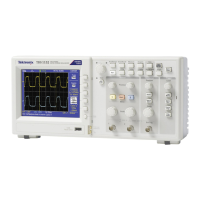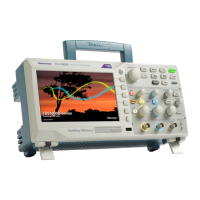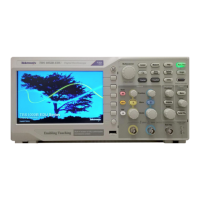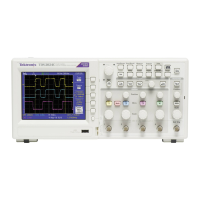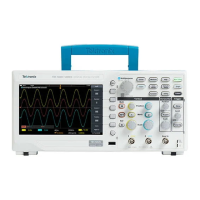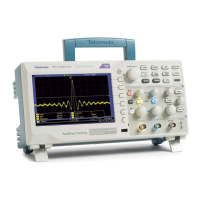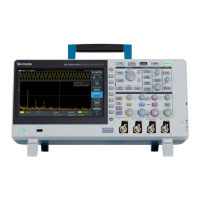
Do you have a question about the Tektronix TBS1202B and is the answer not in the manual?
| Bandwidth | 200 MHz |
|---|---|
| Channels | 2 |
| Vertical Resolution | 8-bit |
| Timebase Range | 5 ns/div to 50 s/div |
| Sample Rate | 2 GS/s |
| Record Length | 2.5 kpoints |
| Display | 7-inch WVGA (800 x 480) LCD |
| Input Voltage Range | 300 V |
| Trigger Types | Edge, Pulse Width, Video |
| Interfaces | USB, LAN |
| Weight | 2.5 kg |
| Input Impedance | 1 MΩ |
| Power Supply | 100 V to 240 V |
General precautions for safe operation and to prevent injury or damage.
Precautions to prevent fire and personal injury during operation.
Safety precautions and guidelines for using oscilloscope probes and test leads.
Safety information specific to performing service procedures on the product.
Instructions for installing the product and connecting power sources.
Safety precautions for probes and procedure for manual probe compensation.
How to select and set the probe attenuation factor for correct measurements.
Scaling for current probes and the procedure for self-calibration.
Explanation of the display area and its various readouts and icons.
How to use menus and vertical controls for positioning and scaling waveforms.
Explanation of horizontal controls for position and scale adjustment.
Explanation of the trigger menu, level control, and force trigger function.
Details on the functions of front-panel buttons and the multipurpose knob.
General information on setting up the oscilloscope for operation.
Using Autoset, Autorange, saving, and recalling oscilloscope setups.
Explanation of how the oscilloscope triggers and selects trigger sources.
Description of trigger types, modes, coupling, and position settings.
How signals are acquired and the different acquisition modes available.
Adjusting waveform display and understanding time domain aliasing.
Methods for taking measurements using the graticule and cursors.
Using time cursors and the Measure Menu for automatic measurements.
Description of the Acquire button, modes (Sample, Peak Detect, Average), and acquisition intervals.
How the Autorange function automatically adjusts settings to track signals.
How the Autoset button adjusts controls for a usable input signal display.
How to display measurement cursors and adjust their position.
How to choose waveform presentation and adjust display appearance.
Options for FFT function, including source channel, window algorithm, and zoom factor.
How to adjust trigger point location and horizontal scale using horizontal controls.
How to access automatic measurements and display them on the screen.
Managing reference waveforms and saving/recalling setups, images, or waveforms.
Instructions for connecting and compensating passive probes to the oscilloscope.
Procedure for compensating probes to optimize low-frequency measurements.
Safety precautions for probes and definitions of safety terms and symbols.

